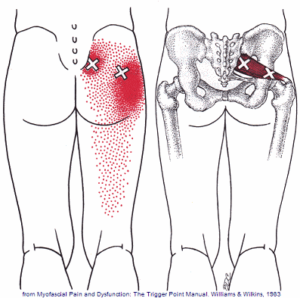The Piriformis
The piriformis muscle is a very important muscle that lies deep in your buttocks. Oftentimes, runners are affected by stress and injury to this muscle, but it can definitely be a problem for everyone. As seen in the picture above, it sits just on top of the sciatic nerve. In approximately 15% of people, the sciatic nerve actually travels right through the muscle!!! Could you imagine??? Anytime that muscle becomes inflamed or injured, pressure can be applied on the nerve causing a host of issues.
The main function of the piriformis muscle is lateral (external) rotation of the hip when the hip is extended. Think of it this way…when standing, the piriformis acts to rotate your leg so that the toe points away from the body. Other lateral rotators of the hip include the superior gemellus , obturator externus, obturator internus, inferior gemellus and quadratus femoris. When learning these muscles in Anatomy class, we used this pneumonic…”please send out information quickly”. P for piriformis; S for superior gemellus; O for both obturators; I for inferior gemellus; and Q for quadratus femoris. When the hip is flexed, however, the piriformis has a different action. It actually abducts the femur (thigh bone) meaning it brings the femur away from the body. Abduction of the thigh with hip flexion is a very important movement during the gait cycle when walking by shifting the body weight to the opposite side of the foot that is lifted which prevents falling.

Injury to the piriformis muscle can lead to trigger point formation. When trigger points are formed, pain manifests. The figure above demonstrates referral patterns of pain when the trigger points are active. Also, depending on the severity of injury, an inflamed piriformis muscle can apply pressure to the sciatic nerve causing sciatica symptoms to occur. This is called Piriformis Syndrome. As seen in the figure, irritation of the piriformis can refer pain to the sacroiliac region of the low back which can make diagnosis of the syndrome difficult. If the sciatic nerve is involved, you will experience pain down the back of the leg into the calf and maybe even all the way into the foot. If the syndrome goes untreated, numbness, tingling and weakness may happen as well.

Due to the action of the muscle itself, symptoms worsen with prolonged sitting and with activity…such as running, especially uphill. There are a wide variety of risk factors that may increase the likelihood of developing piriformis syndrome:
- – running
- – sedentary jobs where you sit most of the day, especially in a chair where your knees sit higher than your hips
- – having a longer second toe
- – overpronation of the foot during the gait cycle (see the figure above – the arch flattens too much causing the foot to roll inward)
- – one leg longer than the other which throws your pelvis off balance
- – misalignment of your sacroiliac joint (GO SEE YOUR CHIROPRACTOR!!!)
There are also a wide variety of causes of piriformis syndrome:
- – a direct blow to the muscle
- – running
- – sitting on your foot
- – catching yourself from falling or other sudden muscle overload
- – car accidents, especially when hit from the driver’s side
- – twisting while lifting a heavy object
There are several different ways to attack piriformis syndrome. There is not one treatment better than another, but combining treatments like moist heat, myofascial release, stretching and chiropractic adjustments seem to help the most. Moist heat helps to penetrate deeper into the muscle to promote blood flow into the affected area. This can help to relax the tissue and speed healing times. Apply the heat for about 20 minutes then you can move on to stretching and myofascial release. Using a foam roller or a tennis ball are great ways to apply pressure to the existing trigger points to relieve the tension and relax the muscle, thus reducing symptoms. Do this for a few minutes 3-4 days per week. Stretching the piriformis can also help relax the muscle. There are a few different version of the stretch so be sure to find the one best suited for you. Hold the stretch for about 10 seconds. You want to feel a light stretch without pain. If you feel pain, back off on the stretch. Always stretch both sides…even if only one side is bothering you! Supplement these great at-home exercises with consistent chiropractic adjustments. Not only will the adjustment help to realign the pelvis, it will reset your central nervous system and relieve pressure from nerves and improve the function of the muscles those nerves supply. At Pro Chiropractic, we also have a state of the art dynamic gait scanning system that can help us to determine how your feet move throughout your gait cycle and allow us to create custom orthotics to fix any issues…such as over pronation!!! We can also correct a leg length deficiency with orthotics by adding a heel lift if necessary.
